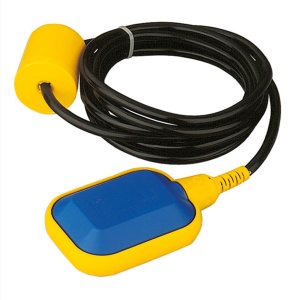You are using an out of date browser. It may not display this or other websites correctly.
You should upgrade or use an alternative browser.
You should upgrade or use an alternative browser.
What are you currently working on??
- Thread starter backwoods
- Start date
Yea burns got to be one the more painful injuries one can get..I had to take off work on Tuesday to repair my secondary well pump. My reserve tank got too low and pump ran for who knows how long. It heated the water in the pipe and when I shut off the pump, the PVC check valve blew apart.
View attachment 90892
View attachment 90893
When I reached over to turn off the pump, I guess the jolt of the pump shutting off is what caused the pipe to blow. My unlucky butt was standing right by it, I got sprayed with probanly 150-160*water. I ended up with 1st and 2nd degree burns up my leg, some on my stomach. Wearing jeans all week has sucked, but blisters are finally getting some new skin over them.
I've had so many projects this week to do, but I've not done anything all week.
View attachment 90891.
It would not be so bad if I didn't have one on my upper thigh where my pants crease when I walk, it rubs with every stride.Yea burns got to be one the more painful injuries one can get..
Pantyhose?It would not be so bad if I didn't have one on my upper thigh where my pants crease when I walk, it rubs with every stride.
Dang, Marty hope you get some relief from that fast! PVC definitely don't like heat! We had several meltdowns like that at work. Fortunately no one got sprayed with hot water. Electricians would install low water shutoff floats after it happened a few times.
DAC
DAC
Dang, Marty hope you get some relief from that fast! PVC definitely don't like heat! We had several meltdowns like that at work. Fortunately no one got sprayed with hot water. Electricians would install low water shutoff floats after it happened a few times.
DAC
We always used flow valves on the outlets of pumps on a timer. If they didn’t see water flow on the outlet the pump would shut down for a period of time before it tried again.
Those saved a lot of pumps over time and probably injury.
Not sure how one would make that work on a well pump. On the suction line maybe. That way if it didn’t see flow it would shut down.
Last edited:
Sounds like a good gadget, Aaron. Wasn't thought of by city engineers in our case obviously!We always used flow valves on the outlets of pumps on a timer. If they didn’t see water flow on the outlet the pump would shut down for a period of time before it tried again.
Those saved a lot of pumps over time and probably injury.
Not sure how one would make that work on a well pump. On the suction line maybe. That way if it didn’t see flow it would shut down.
I should have said that at one time the plant I worked at didn't have on site potable water. We had several 1000 gallon water tanks that had pumps hooked to them with a water level start float in them. Sometimes something would cause abnormal water usage and that was when the tanks sometimes ran out and the pump would run until it would heat whatever it was plumbed into up badly. Had no alarms to the on call phone then either. Would find it the next morning doing rounds. Pumps would burn up too along with the melted PVC fittings and what was left in the tank before the pump would suck some air and lose prime, would be on the floor in the buildings.
DAC
Sounds like a good gadget, Aaron. Wasn't thought of by city engineers in our case obviously!
I should have said that at one time the plant I worked at didn't have on site potable water. We had several 1000 gallon water tanks that had pumps hooked to them with a water level start float in them. Sometimes something would cause abnormal water usage and that was when the tanks sometimes ran out and the pump would run until it would heat whatever it was plumbed into up badly. Had no alarms to the on call phone then either. Would find it the next morning doing rounds. Pumps would burn up too along with the melted PVC fittings and what was left in the tank before the pump would suck some air and lose prime, would be on the floor in the buildings.
DAC
It wouldn’t have been a huge undertaking to install level indicators that reported to a computer system. That computer could have been set up to text or send alerts to people that the tank level was low and it could also shut the pump down.
We had a setup like that on several large water tanks that stored water for any surge water usage underground. These tanks were checked once a day with a drive by otherwise never touched.
You didn't work for the cheap @$$ city government I did, Aaron---LOL! Then then once called out we would have had no way to fill the tanks anyway. They hated paying a contractor to haul water to us but wouldn't get the city water system finished to the plant either! We had a decent SCADA system for on call purposes but it was never a priority to get the water tanks and pumps set up on it, even though the industrial electrician kept hounding management to do it!It wouldn’t have been a huge undertaking to install level indicators that reported to a computer system. That computer could have been set up to text or send alerts to people that the tank level was low and it could also shut the pump down.
We had a setup like that on several large water tanks that stored water for any surge water usage underground. These tanks were checked once a day with a drive by otherwise never touched.
DAC
Back when I worked for the state I had waste water lift station that operated on two of the floating switch type set ups, Modern back then 50 years ago. Nothing more than a steel ball rolling inside a plastic bulb to make contact between two pieces of SS strips. One would turn the pump on and the other would shut it down at low water level. This was down inside a underground tank and small pump room. Turn on switch failed and flooded the pump room back through a dehumidifier that was plumbed in wrong. Had two 7.5 hp electric motors and one rotophase under water. Took a day to get the water pumped out of the pump room and then a couple days getting the three electrical item unhooked and up out of the there. Was down for a week before we got back going again. Those same mechanical switches are still used on some sump pumps, a bubble of plastic on a short cord turn them on and off.
Aaron, I don't know if a flow sensor would work in this setup.
We use stainless ball floats in our hydraulic cooling tanks we build, they shut off the pump if fluid level drops too low. I have contacted company we use and waiting for their reply on the best float for me, I will use a plastic one like below, normally closed with water, switch opens when water level drops too low killing pump. My plant manager already told me we have a bunch of used relay/switch boxes I can have so I'm good there.
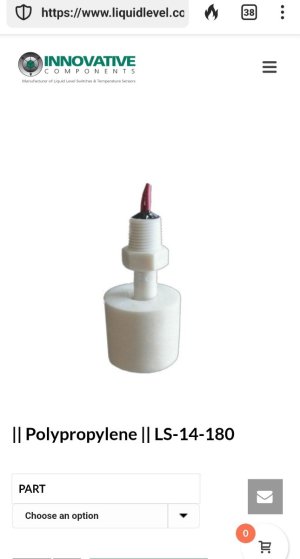
We use stainless ball floats in our hydraulic cooling tanks we build, they shut off the pump if fluid level drops too low. I have contacted company we use and waiting for their reply on the best float for me, I will use a plastic one like below, normally closed with water, switch opens when water level drops too low killing pump. My plant manager already told me we have a bunch of used relay/switch boxes I can have so I'm good there.

Welded these up Friday at work, they are adapters between our units and a gearbox or motor. They are currently on a lathe getting faced off and holes drilled.
You can see my first one, crappy welds then I switched to a better position and welds got more consistent. It's an art welding around a pipe IMO
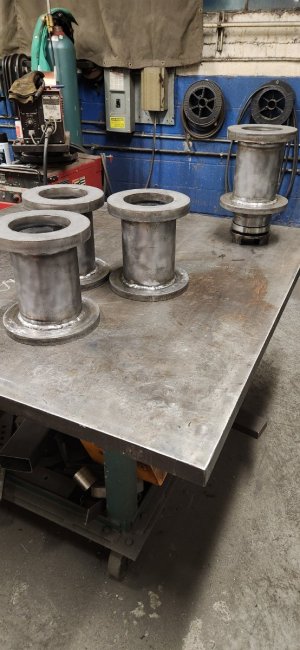
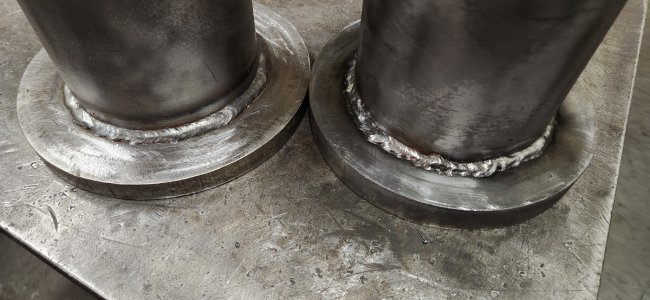
You can see my first one, crappy welds then I switched to a better position and welds got more consistent. It's an art welding around a pipe IMO


Back when I worked for the state I had waste water lift station that operated on two of the floating switch type set ups, Modern back then 50 years ago. Nothing more than a steel ball rolling inside a plastic bulb to make contact between two pieces of SS strips. One would turn the pump on and the other would shut it down at low water level. This was down inside a underground tank and small pump room. Turn on switch failed and flooded the pump room back through a dehumidifier that was plumbed in wrong. Had two 7.5 hp electric motors and one rotophase under water. Took a day to get the water pumped out of the pump room and then a couple days getting the three electrical item unhooked and up out of the there. Was down for a week before we got back going again. Those same mechanical switches are still used on some sump pumps, a bubble of plastic on a short cord turn them on and off.
We used a lot of those dual float setups around the plant. They neglected to let us put them in the water tanks, until after a few fried pumps and melted pvc, plus the industrial electrician hounding them for it. Attaching the cord where the "swing" is just right can be a little difficult. Glad you are able to score some parts from work, Marty! I also had one similar to your picture here at home for quite a while when we still were using the well. High water table years and wet springs would cause the well pit to flood. I had a stainless HF submersible pump with a built in float switch that pumped out the pit through 250' of 1-1/2" hose. The float on the pump quit working so I had to buy one like you had. There again getting the swing right was a bit of a trial and error deal. The pump was wore out when we went to the water system last December, but I sold the switch and the hose on FB to get it out of the shed.Aaron, I don't know if a flow sensor would work in this setup.
We use stainless ball floats in our hydraulic cooling tanks we build, they shut off the pump if fluid level drops too low. I have contacted company we use and waiting for their reply on the best float for me, I will use a plastic one like below, normally closed with water, switch opens when water level drops too low killing pump. My plant manager already told me we have a bunch of used relay/switch boxes I can have so I'm good there.
I will have to be working on a shop furnace repair or replacement very soon due to a cracked heat exchanger.
DAC
Last edited:
Been trying to clean up some cast iron i picked up a while back. Base for a waffle iron I don't think had ever been cleaned as the carbon is really think and crusty. 4th or 5th application of the Carbon Off is slowly getting in . More comes lose after each application. Won't be a user, just one to put on the rack so not going to get real fussy with it.
I'll take 2 please! For this,Welded these up Friday at work, they are adapters between our units and a gearbox or motor. They are currently on a lathe getting faced off and holes drilled.
You can see my first one, crappy welds then I switched to a better position and welds got more consistent. It's an art welding around a pipe IMO
View attachment 90914
View attachment 90913
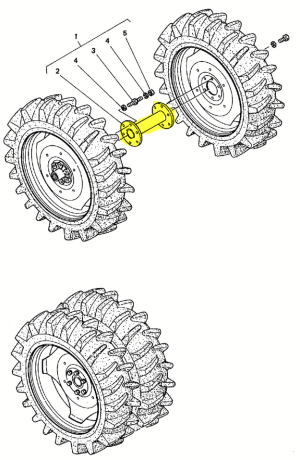
To do this,

Last edited:
Windage and elevation!,Welded these up Friday at work, they are adapters between our units and a gearbox or motor. They are currently on a lathe getting faced off and holes drilled.
You can see my first one, crappy welds then I switched to a better position and welds got more consistent. It's an art welding around a pipe IMO
Newer welders simplify the settings. After that it is hand speed and positioning.
Oh yeah, lots of practice too.
They would have worked for that.
Rick, my biggest issue is eyesight, I'm very near sighted and need bifocals, I have to be in a position to see well and be able to move.
I started being over the top of the gun and moving it straight backwards, but then switched to having it angled to one side so I could see the side of the gun and not over top. This also helped me move it easier and make a longer pass before stopping. I made it in 2- 1/2 length passes around versus starting at 3 to 4- 1/4 length passes
You're talking paint gun I think
I have painted small parts with a gun several times since then, last time I went to Lowe's and raised their cardboard boxes, brought home a couple of refrigerator boxes, raised my 2 post lift about halfway and made a 3 sided paint booth, leaning the opened up boxes against the arms of the lift. I was spraying some blue engine paint (por 15 brand) and couldn't get it to cover for shut. After about 4 coats the parts I was spraying looked more like anodized, and I could still see the gray primer.
I last painted a car in the 80s, with Dupont Centari. I have a truck that I need painted, for the price I was quoted (not even counting materials) I may have to learn how to do it again....
I have painted small parts with a gun several times since then, last time I went to Lowe's and raised their cardboard boxes, brought home a couple of refrigerator boxes, raised my 2 post lift about halfway and made a 3 sided paint booth, leaning the opened up boxes against the arms of the lift. I was spraying some blue engine paint (por 15 brand) and couldn't get it to cover for shut. After about 4 coats the parts I was spraying looked more like anodized, and I could still see the gray primer.
I last painted a car in the 80s, with Dupont Centari. I have a truck that I need painted, for the price I was quoted (not even counting materials) I may have to learn how to do it again....

